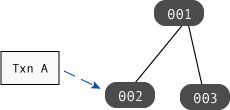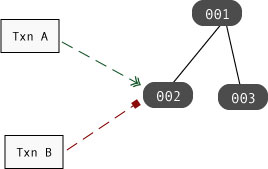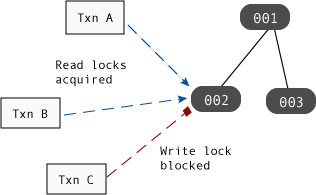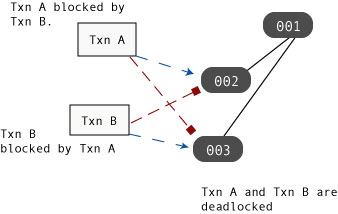It is important to understand how locking works in a concurrent application before continuing with a description of the concurrency mechanisms JE makes available to you. Blocking and deadlocking have important performance implications for your application. Consequently, this section provides a fundamental description of these concepts, and how they affect JE operations.
When one thread of control wants to obtain access to an object, it requests a lock for that object. This lock is what allows JE to provide your application with its transactional isolation guarantees by ensuring that:
-
no other thread of control can read that object (in the case of an exclusive lock), and
-
no other thread of control can modify that object (in the case of an exclusive or non-exclusive lock).
When locking occurs, there are conceptually three resources in use:
-
The locker.
This is the thing that holds the lock. In a transactional application, the locker is a transaction handle. For non-transactional operations, the locker is the current thread.
-
The lock.
This is the actual data structure that locks the object. In JE, a locked object structure in the lock manager is representative of the object that is locked.
-
The locked object.
The thing that your application actually wants to lock. In a JE application, the locked object is usually a database record.
JE has not set a limit for the maximum number of these resources you can use. Instead, you are only limited by the amount of memory available to your application.
The following figure shows a transaction handle,
Txn A, that is holding a lock on
database
record
002. In this graphic, Txn
A is the locker, and the locked object is
record
002. Only a single lock is in use
in this operation.

JE applications support both exclusive and non-exclusive locks. Exclusive locks are granted when a locker wants to write to an object. For this reason, exclusive locks are also sometimes called write locks.
An exclusive lock prevents any other locker from obtaining any sort of a lock on the object. This provides isolation by ensuring that no other locker can observe or modify an exclusively locked object until the locker is done writing to that object.
Non-exclusive locks are granted for read-only access. For this reason, non-exclusive locks are also sometimes called read locks. Since multiple lockers can simultaneously hold read locks on the same object, read locks are also sometimes called shared locks.
A non-exclusive lock prevents any other locker from modifying the locked object while the locker is still reading the object. This is how transactional cursors are able to achieve repeatable reads; by default, the cursor's transaction holds a read lock on any object that the cursor has examined until such a time as the transaction is committed or aborted.
In the following figure, Txn A and
Txn B are both holding read locks on
record
002, while Txn C
is holding a write lock on
record
003:

A locker holds its locks until such a time as it does not need the lock any more. What this means is:
-
A transaction holds any locks that it obtains until the transaction is committed or aborted.
-
All non-transaction operations hold locks until such a time as the operation is completed. For cursor operations, the lock is held until the cursor is moved to a new position or closed.
Simply put, a thread of control is blocked when it attempts to obtain a lock, but that attempt is denied because some other thread of control holds a conflicting lock. Once blocked, the thread of control is temporarily unable to make any forward progress until the requested lock is obtained or the operation requesting the lock is abandoned.
Be aware that when we talk about blocking, strictly speaking the thread is not what is attempting to obtain the lock. Rather, some object within the thread (such as a cursor) is attempting to obtain the lock. However, once a locker attempts to obtain a lock, the entire thread of control must pause until the lock request is in some way resolved.
For example, if Txn A holds a write lock (an exclusive
lock) on
record
002, then if Txn B tries to obtain a read or write lock on
that
record,
the thread of control in which Txn
B is running
is blocked:

However, if Txn A only holds a read
lock (a shared lock) on
record
002, then only those handles that attempt to obtain a
write lock on that
record
will block.

Multi-threaded applications typically perform better than simple single-threaded applications because the application can perform one part of its workload (updating a database record, for example) while it is waiting for some other lengthy operation to complete (performing disk or network I/O, for example). This performance improvement is particularly noticeable if you use hardware that offers multiple CPUs, because the threads can run simultaneously.
That said, concurrent applications can see reduced workload throughput if their threads of control are seeing a large amount of lock contention. That is, if threads are blocking on lock requests, then that represents a performance penalty for your application.
Consider once again the previous diagram of a blocked write lock request.
In that diagram, Txn C cannot
obtain its requested write lock because
Txn A and Txn
B are both already holding read locks on
the requested
record.
In this case, the thread in which
Txn C is running will pause until
such a time as Txn C either
obtains its write lock, or the operation
that is requesting the lock is abandoned.
The fact that Txn
C's thread has temporarily halted all
forward progress represents a performance penalty
for your application.
Moreover, any read locks that are requested while
Txn C is waiting for its write
lock will also block until such a time as
Txn C has obtained and
subsequently released its write lock.
Reducing lock contention is an important part of performance tuning your concurrent JE application. Applications that have multiple threads of control obtaining exclusive (write) locks are prone to contention issues. Moreover, as you increase the numbers of lockers and as you increase the time that a lock is held, you increase the chances of your application seeing lock contention.
As you are designing your application, try to do the following in order to reduce lock contention:
-
Reduce the length of time your application holds locks.
Shorter lived transactions will result in shorter lock lifetimes, which will in turn help to reduce lock contention.
In addition, by default transactional cursors hold read locks until such a time as the transaction is completed. For this reason, try to minimize the time you keep transactional cursors opened, or reduce your isolation levels – see below.
-
If possible, access heavily accessed (read or write) items toward the end of the transaction. This reduces the amount of time that a heavily used record is locked by the transaction.
-
Reduce your application's isolation guarantees.
By reducing your isolation guarantees, you reduce the situations in which a lock can block another lock. Try using uncommitted reads for your read operations in order to prevent a read lock being blocked by a write lock.
In addition, for cursors you can use degree 2 (read committed) isolation, which causes the cursor to release its read locks as soon as it is done reading the record (as opposed to holding its read locks until the transaction ends).
Be aware that reducing your isolation guarantees can have adverse consequences for your application. Before deciding to reduce your isolation, take care to examine your application's isolation requirements. For information on isolation levels, see Isolation.
-
Consider your data access patterns.
Depending on the nature of your application, this may be something that you can not do anything about. However, if it is possible to create your threads such that they operate only on non-overlapping portions of your database, then you can reduce lock contention because your threads will rarely (if ever) block on one another's locks.
A deadlock occurs when two or more threads of control are blocked, each waiting on a resource held by the other thread. When this happens, there is no possibility of the threads ever making forward progress unless some outside agent takes action to break the deadlock.
For example, if
Txn A is
blocked by Txn B at the same time
Txn B is blocked by Txn
A then the threads of control containing
Txn A and Txn B are
deadlocked; neither thread can make
any forward progress because neither thread will ever release the lock
that is blocking the other thread.

When two threads of control deadlock, the only solution is to have a mechanism external to the two threads capable of recognizing the deadlock and notifying at least one thread that it is in a deadlock situation. Once notified, a thread of control must abandon the attempted operation in order to resolve the deadlock. JE is capable of notifying your application when it detects a deadlock. (For JE, this is handled in the same way as any lock conflict that a JE application might encounter.) See Managing Deadlocks and other Lock Conflicts for more information.
Note that when one locker in a thread of control is blocked waiting on a lock held by another locker in that same thread of the control, the thread is said to be self-deadlocked.
Note that in JE, a self-deadlock can occur only if two or more transactions (lockers) are used in the same thread. A self-deadlock cannot occur for non-transactional usage, because the thread is the locker. However, even if you have only one locker per thread, there is still the possibility of a deadlock occurring with another thread of control (it just will not be a self-deadlock), so you still must write code that defends against deadlocks.
The things that you do to avoid lock contention also help to reduce deadlocks (see Avoiding Blocks). Beyond that, you should also make sure all threads access data in the same order as all other threads. So long as threads lock records in the same basic order, there is no possibility of a deadlock (threads can still block, however).
Be aware that if you are using secondary databases (indexes), then locking order is different for reading and writing. For this reason, if you are writing a concurrent application and you are using secondary databases, you should expect deadlocks.